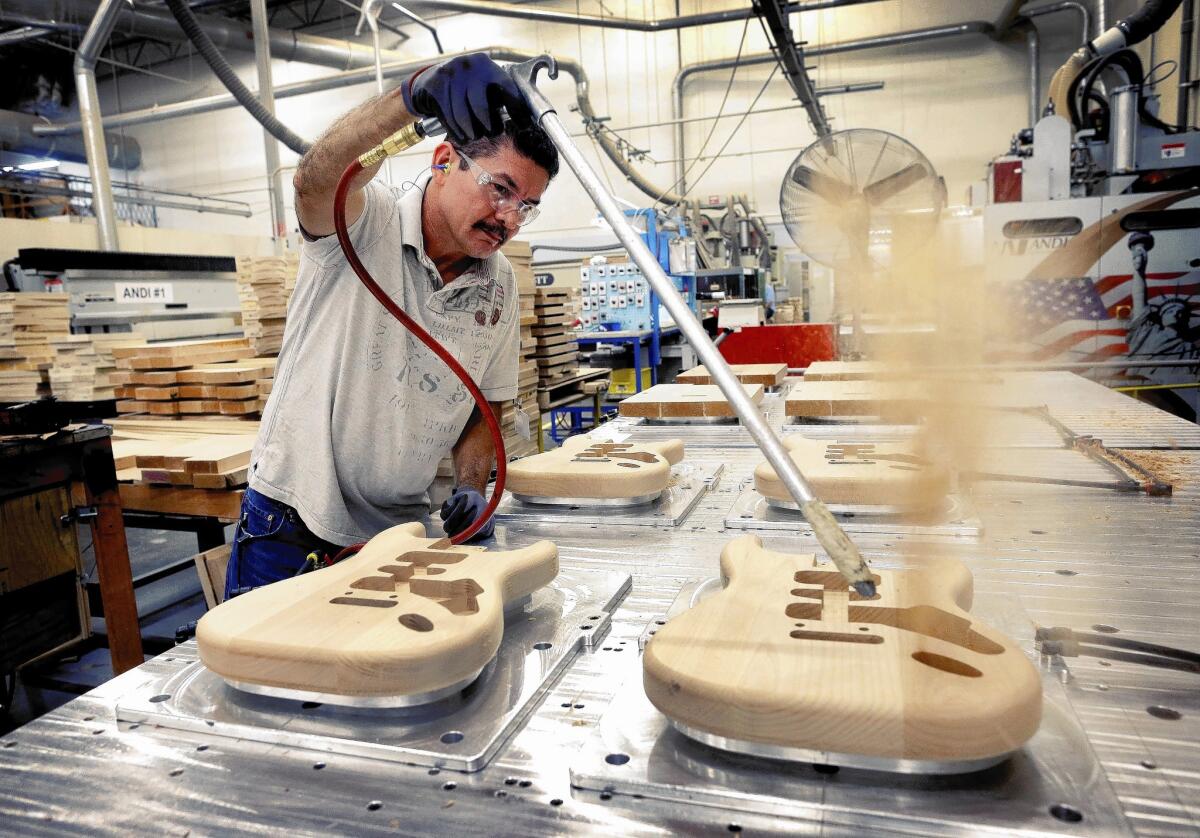Factory output in California surging despite job losses

- Share via
California manufacturers really can do more with less.
The output of state factories has surged 73% during the last 15 years — twice as fast as the rest of the nation — even as the sector bleeds jobs, according to a new report from the Los Angeles County Economic Development Corp. Employment declined nearly 34% during the same period.
The surge in production owes itself to innovations in machinery and materials, digitization and computing power, along with a strong network of industry clusters.
Under pressure from automation, offshoring and aggressive cost-cutting, the state’s manufacturing workforce shriveled to 1.2 million in 2012 from 2.1 million jobs in 1990 — a faster rate of decline than the nation as a whole.
The difference exceeds the total number of current manufacturing positions in all of Southern California.
“The composition of manufacturing is going to change and has been changing,” LAEDC economist Christine Cooper said. “It’s becoming more advanced and technologically intensive. And it’s more lean.”
Key California industries such as aerospace, biomedicine and fashion benefit from having entire supply chains in the same region or even within a few square blocks, encouraging innovation and boosting efficiency, according to the report.
Nationwide, manufacturing accounts for three-quarters of private sector research and development and the majority of patents issued, Jason Miller, special assistant to President Obama for manufacturing policy, said in a Brookings Institution presentation last week.
In 2013, manufacturing entrepreneurship grew at its fastest pace in 20 years, Miller said. That’s due in part to new technological advances, such as 3-D printers and digital production, which lower the cost of manufacturing and reduce the time required to make prototypes and commercialize new items.
“Manufacturing is inextricably linked to our country’s ability to innovate, and therefore linked to our future economic growth potential,” Miller said. “We like to say manufacturing punches above its weight.”
As of 2012, the largest group of California manufacturing jobs were those producing semiconductors and other electronic components. The cluster, largely in Northern California, accounts for more than 7% of the state’s manufacturing jobs, according to the LAEDC report.
Southern California hosts the second-largest category of workers, which makes navigational and control instruments for aerospace companies, according to the LAEDC report. That sector claims a 6.6% share of state manufacturing employment.
Overall, the lower half of the state accounts for two-thirds of total manufacturing employment in the state, with more than 814,000 workers.
In May, the U.S. Commerce Department announced that Southern California would be one of the first dozen U.S. regions to receive federal support to lure more manufacturers. The program will try to increase local manufacturing capacity by luring private investment and boosting exports.
Participants will have access to experts in 11 federal agencies and $1.3 billion in funding.
Los Angeles County had more than 365,500 manufacturing jobs in 2012, making up 9.2% of total countywide employment and nearly 30% of all manufacturing jobs across the state. As a producer, the region is most competitive in the fashion and aerospace industries.
But as California’s economy diversifies, manufacturing is becoming a less dominant part of the state’s economic identity.
Manufacturing now accounts for 10.7% of the total value of all goods and services produced in the state, compared with 11.6% in 1990.
The sector suffered more intensely during the recession and recovered more slowly than many other sectors of the state economy. Employment in other California industries soared 22.5% since 1990 as the measure sank for manufacturers.
Most of the manual labor that was used to create high-volume, low-margin products has shifted abroad, said Jim Watson, president of California Manufacturing Technology Consulting. The nonprofit consulting firm in Torrance commissioned the LAEDC research.
“As technology begins to increase productivity and innovation begins to take hold, you’ll begin to see some manufacturing growth, which will lead to some jobs,” he said. “But I don’t believe that many of the jobs that have been lost are going to come back, and if they do, they won’t be the same kinds of jobs.”
Follow Tiffany Hsu on Twitter at @tiffhsulatimes
More to Read
Inside the business of entertainment
The Wide Shot brings you news, analysis and insights on everything from streaming wars to production — and what it all means for the future.
You may occasionally receive promotional content from the Los Angeles Times.











